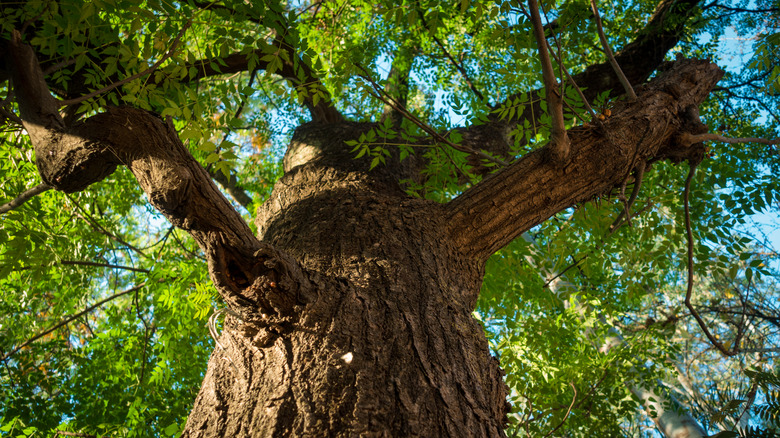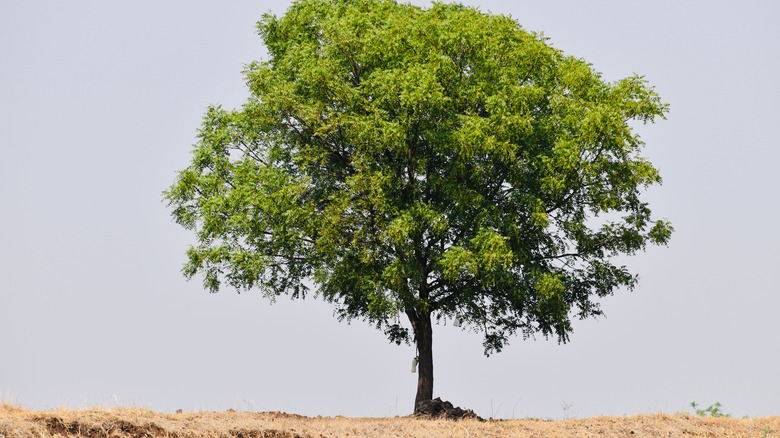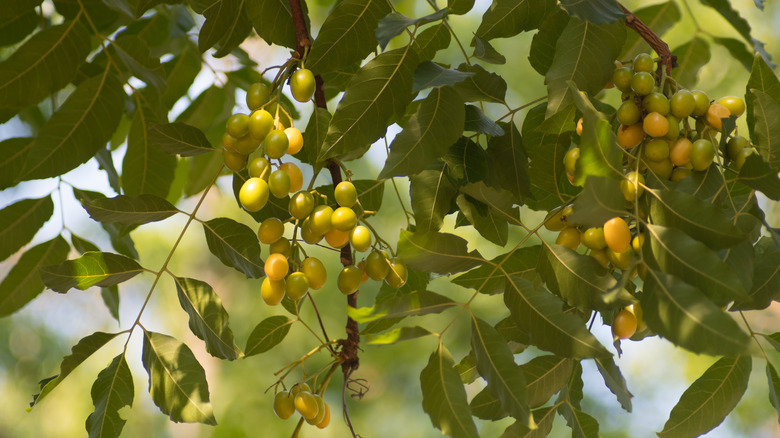These Are The Places In The U.S. Where Neem Trees Can Thrive
The neem tree, Azadirachta indica, is an attractive and useful member of the mahogany family. It's a fast-growing tree that can reach impressive sizes — up to 98 feet tall and 8 feet wide in the trunk. Although neem trees are native to the tropical regions of India and Southeast Asia, it is possible — and even easy — to grow them in some parts of the U.S. Here, we'll discuss why you might want to plant a neem tree, the best places in North America to grow them, and how to keep them happy.
Neem trees are something of a wonder plant. They develop deep taproots (up to twice the length of the trunk), which help them survive in some of the world's harshest climates and recover quickly from damage. People living in hot, arid regions often use them to create much-needed shade and improve soil health. They're also attractive for reforesting dry, inhospitable regions like Africa's Sahel (the savanna immediately south of the Sahara desert).
Neem trees are a source of many valuable products. Their leaves can be dried and used as fodder for livestock. Neem oil, extracted from the tree's fruit, is an effective natural pesticide that can be used to combat a wide variety of pests, as well as powdery mildew. After the oil is extracted, the leftover seedcake makes an excellent fertilizer. Neem lumber is valuable as both a building material and fuel; neem trees are often planted in regions to be used as fuel.
Where to plant neem trees
Neem trees are native to hot, moist, tropical climates — not exactly what the U.S. is known for. They're best suited to USDA growing zones 9 and 10, which cover Hawaii, Puerto Rico, southern Florida, southern Texas, and parts of the West Coast. With the right care, they can also thrive in desert environments, including frost-free regions of southern Arizona and California. Virtually no place is too hot for neem trees; they've been known to survive in regions where the shade temperature exceeds 122 degrees Fahrenheit.
Although neem trees prefer year-round heat, they may still grow well in regions of the southern and western U.S. that are prone to occasional frosts. They can withstand temperatures as low as 30 degrees Fahrenheit without sustaining damage. If the temperature drops into the 20s, they will die back to the ground. But these trees are survivors — a little snow isn't enough to totally kill them. Neem roots will stay healthy during cold snaps, and the tree will start to regrow when the temperature rises again. If your home climate experiences frequent freezes, your neem tree will grow into more of a shrub than a tree due to the frequent die-backs.
Neem trees are hardy, adaptable plants that can survive almost anywhere as long as the temperature is right. That's good news for newbie neem gardeners, who will find this plant difficult to kill. With a basic understanding of your neem tree's needs, you can keep it healthy and happy, even in nonideal regions of the U.S.
Neem tree care and maintenance
No matter where you live in the U.S., plant your neem tree in a location where it will get plenty of sunlight. If your area is prone to frost, plant your tree shortly after the last spring frost to give it as much time as possible to develop a robust root system before winter returns. Water your tree heavily but infrequently — always let the soil dry out between waterings to prevent root rot, which can be fatal to neem trees. If you plan to harvest your tree's leaves or fruit, fertilize it regularly. Experts recommend using a fertilizer designed for citrus trees.
If planting neem in a desert area, you must gradually acclimate the tree to its new arid climate. Start by keeping it in a pot, and choose a location where it will only get partial sun. The dry climate may cause the leaves to wilt; combat this by spritzing the leaves with water rather than watering the soil more. Once the tree is established in the pot and seems to be doing well, you can move it to the ground and into an area with more sun. Desert regions often have clay-rich soil, which isn't ideal for neem trees. Set your tree up for success by amending the soil: Dig an extra-large hole for your tree, remove some of the clay, and refill with high-quality potting soil. Take good care of your neem tree, and it will reward you with vigorous growth and plenty of useful fruit.


